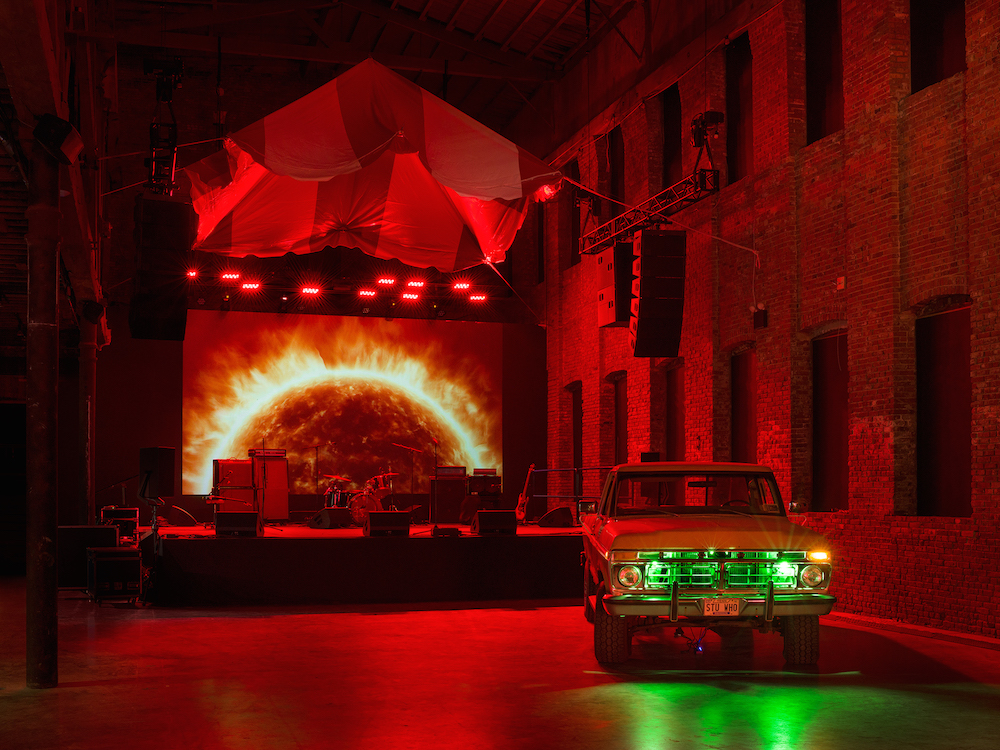Willie Stewart and Brent Stewart’s Long Strange Trip
Willie Stewart and Brent Stewart initially met by chance, sizing each other up across the room in a Nashville bar. “When I first met Brent, he had on a damn all-white tracksuit and his hair was cut, and he was like, ‘Man, I’ve been living in England,'” Willie recalls. “I was like, ‘I’m making a 4-foot by 4-foot colored pencil drawing of Kiss’s Destroyer album cover.’ He was like, ‘I want to see it.'” As it turned out, they had plenty to talk about. The artists and Tennessee natives—no relation, coincidentally—soon channeled their mutual obsessions for the same strains of cinema, music, and genre flick mythology into a collaborative art practice.
Brent received his MFA from Goldsmiths in London and debuted his short film The Dirty Ones at Sundance in 2009. Willie, once a guitarist for Yoko Ono, grew up in a motorcycle club and is currently a sculpture MFA candidate at Yale. Last summer, the duo debuted two shows in Nashville: “Freebird,” a video installation and performance (in which the two sat in a parked car listening to Neil Young’s Zuma) at the Zeitgeist gallery, and “Runners,” another video work at Seed Space, which was accompanied by an immersive, walk-in installation of a Unabomber-esque wooden shack dressed with various ephemera and survivalist artifacts.
Together, the Stewarts have a propensity towards building realized worlds that plumb the errant depths of the subconscious, with one foot deep in the Southern lexicon of their upbringing and an eye towards the abject, bizarre, and supernatural. And now, the pair has unveiled their most ambitious project to date. “Grand Ole Opera,” now open at Pioneer Works in Red Hook and curated by Gabriel Florenz, is perhaps the strongest manifestation of the Stewarts’s specific idiom of postmodern, sociopolitical pastiche. The title, a riff on the venerable Nashville “Home of American Music,” the Grand Ole Opry, is a nod to disrupting the status quo of the Southern tradition—such as Johnny Cash (who was banned after he drunkenly smashed lights onstage at a 1968 show) and Bob Wills did when performing at the hallowed music venue.
The Stewarts deftly digest the iconography of Southern Americana alongside narratives of other tropes of popular culture and certain subcultures. The figure of the outsider looms large in the exhibition. The opening set piece, a sculpture of red neon lights, bathes a taxidermy deer in its glow, and serves as an unofficial opening to the installation. Brent says the piece “creates a psychic space, a fever dream,” and sets the stage for the other major pieces in the show, including two trailers lit with, per Willie, “Argento-like” supernatural lighting and featuring individual works by Willie and Brent—including Brent’s geometric monochrome paintings, and Willie’s video works and sculptures fashioned in the shape of VHS tapes that reference The Craft and Slacker. A pick-up truck, seemingly possessed with green light, blares AM radio, and the two lifted in the bar from a clubhouse of the biker gang Deth Killers of Bushwick, adding ephemera like an image of Mike Kelley, and a TV that loops a series of vampire performances, such as David Bowie in The Hunger or Brad Pitt in Interview with a Vampire. Next to the bar, the Stewarts built out a room, fashioned to appear as the bar’s bathroom; inside screens the video work Romulus and Remus where the two act out a violent fistfight.
“We wanted it to be like you open a book and right in the middle of a page, you just get those fragments, little residues of things, characters and places and feelings,” Brent explains. “There’s a performance aspect to this part as well. We can be behind the bar and be part of the installation, or just back for the conversation and interaction with people. It’s a whole social space within this installation,” he adds. For instance, the two worked off a “dream list” to program a concert series to take place over the run of the exhibition, including acts like Japanese psychedelic rock act Fushitsusha and doom metal band, Sleep, which will appear onstage underneath a revival tent and in front of a massive video rendering of the sun. The religious devotion of the revival tent—typically used to host Christian sermons, healing ceremonies, and church groups—links the fervor of metal or noise-heads connecting with their favorite bands. “What was interesting to me was, what does it mean to take this tent where all these believers came to, whatever they believed in, to try and fix their life?” Willie says. “In the same way when you see a concert. You’re working every day at your job, waiting for your release. You come here to have some kind of transcendence.”
“GRAND OLE OPERA” IS ON VIEW AT PIONEER WORKS IN NEW YORK THROUGH JULY 30, 2017.







